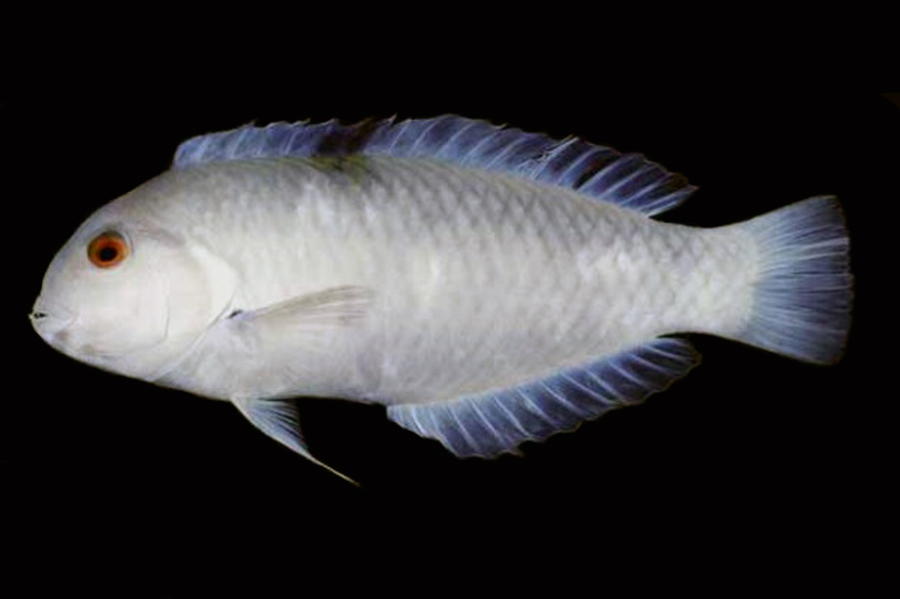Lord Howe Sandy, Novaculops pastellus Randall, Earle & Rocha 2008

A male Lord Howe Sandy, Novaculops pastellus, from Middleton Reef, Tasman Sea, depth 10 m - Paratype BPBM 35027, 117 mm SL . Source: John E. Randall / FishBase. License: CC BY Attribution-Noncommercial
A rare razorfish known only from the Lord Howe Island region in the Tasman Sea. The Lord Howe Sandy inhabits open sandy bottoms, and dives quickly into the sand when threatened.
Males are pale grey above, whitish below, with greenish-grey scale edges and white lateral line pores. They have black membranes between dorsal-fin spines 6 & 7, dark pigment extending obliquely to lateral line, transverse dusky bands on the lower part of the head, and a red iris.
Females are pale bluish-green, with white lateral line pores and dark orange to reddish scale edges that become fine vertical lines on the abdomen.
Lord Howe Sandy, Novaculops pastellus Randall, Earle & Rocha 2008
More Info
|
Distribution |
Known only from Lord Howe Island, and the nearby Elizabeth and Middleton reefs in the Tasman Sea off eastern Australia. Depth range 10-25 m. Inhabits open sandy bottoms, and dives quickly into the sand when threatened - and can move through the sand by undulating the body. |
|
Features |
Dorsal fin IX, 12; Anal fin III, 12 (all branched); Caudal fin 12 principal rays; Pectoral fin 13; Pelvic fin I, 5; Lateral-line scales 20 + 5; Gill rakers 18-20; Vertebrae 25. |
|
Conservation |
|
|
Etymology |
The specific name is from the Latin pastellus, in reference to the soft and subdued colours of this species. |
|
Species Citation |
Xyrichtys pastellus Randall, Earle & Rocha, 2008, aqua, International Journal of Ichthyology 14(3): 150, Figs. 1-3. Type locality: Lord Howe Island, near Admiralty Islands [ca. 31°28'S, 159°04'E]. |
|
Author |
Bray, D.J. 2020 |
|
Resources |
Lord Howe Sandy, Novaculops pastellus Randall, Earle & Rocha 2008
References
Allen, G.R., Hoese, D.F., Paxton, J.R., Randall, J.E., Russell, B.C., Starck, W.A., Talbot, F.H. & Whitley, G.P. 1976. Annotated checklist of the fishes of Lord Howe Island. Records of the Australian Museum 30(15): 365-454 figs 1-2 (as Hemipteronotus sp.)
Francis, M. 1993. Checklist of the coastal fishes of Lord Howe, Norfolk, and Kermadec Islands, southwest Pacific Ocean. Pacific Science 47(2): 136-170 figs 1-2 (as Novaculops sp.)
Francis, M.P. & Randall, J.E. 1993. Further additions to the fish faunas of Lord Howe and Norfolk Islands, southwest Pacific Ocean. Pacific Science 47(2): 118-135 figs 1-22 pls 1-4 (as Novaculops sp.) http://hdl.handle.net/10125/1754
Kuiter, R.H. 2010. Labridae fishes: wrasses. Seaford, Victoria, Australia : Aquatic Photographics 398 pp. (as Novaculops woodi which was treated as a senior synonym of N. pastellus)
Randall, J.E. 2013. Seven new species of labrid fishes fishes (Coris, Iniistius, Macropharyngodon, Navaculops, and Pteragogus) from the Western Indian Ocean.Journal of the Ocean Science Foundation 7: 1-43. http://dx.doi.org/10.5281/zenodo.1041964
Randall, J.E., Earle, J.E. & Rocha, L.A. 2008. Xyrichtys pastellus, a new razorfish from the southwest Pacific, with discussion of the related X. sciistius and X. woodi. aqua, International Journal of Ichthyology 14(3): 149-158.
Yeeting, B., Rocha, L. & Russell, B. 2010. Xyrichtys pastellus. The IUCN Red List of Threatened Species 2010: e.T187629A8584906. http://dx.doi.org/10.2305/IUCN.UK.2010-4.RLTS.T187629A8584906.en. Downloaded on 30 October 2019.



